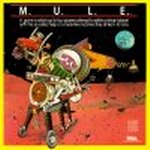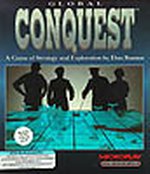
Happy Puppy remembers a pioneer
by Greg Costikyan
| No one on their death bed ever said "I wish I had spent more time alone with my computer!"--Dani Bunten Berry on multiplayer gaming |
I don't mean that she stood six-foot-two, although she did.
I mean that she was one of the great artists of our age, one of the creators of the form that will dominate the 21st century, as film has dominated the 20th and the novel the 19th: the art of game design.
I mean that she displayed a complete mastery of her craft, always pushing the edges of the possible, always producing highly polished work of gem-like consistency and internal integrity.
 When Trip Hawkins founded Electronic Arts, he hit upon the notion of
promoting the best game designers in the field as "stars"--and Dan Bunten
was one of the designers he chose to sponsor. Hawkins wanted to purchase
Cartels and Cutthroats, Dan's preceding game, from SSI, but they refused to sell; Bunten persuaded him that he could do better. The result was M.U.L.E.
When Trip Hawkins founded Electronic Arts, he hit upon the notion of
promoting the best game designers in the field as "stars"--and Dan Bunten
was one of the designers he chose to sponsor. Hawkins wanted to purchase
Cartels and Cutthroats, Dan's preceding game, from SSI, but they refused to sell; Bunten persuaded him that he could do better. The result was M.U.L.E.
Programmed for the Atari 800, M.U.L.E. (Multiple Use Labor Element, the cute labor robots controlled by players in the game) was a humorous game of resource extraction on an alien world. It was designed for up to four players--something the Atari 800 made feasible. It was tense, entertaining, and enormous fun; it's still in the Computer Gaming World Hall of Fame and is, according to legend, the most pirated game in the field's history. Designers still talk of it in hushed tones, and the fact that no version of the game has been developed for a modern gaming platform is an instance either of astonishing oversight or crass philistinism on the part of the major publishers. Many believe it was Dani's single best work. (An aside: when I offered to introduce Warren Spector, producer of many games for Origins and Looking Glass and, now, Ion Storm, to Dani, he regretfully refused; he had loved M.U.L.E. so much he was afraid he wouldn't know what to say. He would sound like a blithering fan-boy and be embarrassed. That is the level of admiration the game arouses in the field.) |
 Dani's single best-selling title was Seven Cities of Gold, a game on the
exploration and conquest of the Americas. Its economic model was simple but
spawned strategies of considerable complexity; its treatment of the Native
Americans faced the player with real moral quandaries. It is also one of the few games whose ports are notably inferior to the game on the original
platform (the Atari 800).
Dani's single best-selling title was Seven Cities of Gold, a game on the
exploration and conquest of the Americas. Its economic model was simple but
spawned strategies of considerable complexity; its treatment of the Native
Americans faced the player with real moral quandaries. It is also one of the few games whose ports are notably inferior to the game on the original
platform (the Atari 800).
|
From the very first, Bunten designed for multiple players, and indeed only two of her games (Seven Cities of Gold and Heart of Africa) were solitaire-only. Her first game, Wheeler Dealers, published in 1978 for the Apple II, came packaged with a custom input device for four people--the only way to permit simultaneous play at the time. Most of Bunten's early work was for the Atari 800, which remains the only personal computer to ship with hardware for play by multiple players; and her games of the late '80s and early '90s (Modem Wars, Command HQ, and Global Conquest) were all designed around modem or network play.
In short, Bunten's games were designed at a time when supporting multiple players was hard. And it is a particular tragedy that her career should be cut short at this unhappy juncture, now that network gaming is burgeoning--a tragedy not solely for Dani, but for all of us, for she understood the requirements and aesthetic of multiplayer gaming better than anyone else in the field.
 Modem Wars was the first computer game to be marketed specifically for
head-to-head modem play, at a time when modems were expensive, owned by a
handful of computer users, and ran at 1200 baud. It was a simple abstract
wargame, with limited lines of sight, fog of war, and an extremely simple
interface. By modern standards, the graphics are primitive, but it was (and
remains) in some sense a far better wargame than many available today.
Among its best features was the ability to support diverse styles of play.
Military strategy played a role; so did hand-eye coordination, in guiding
your drones and missiles to their targets; so did pattern-recognition in
grasping what the radar display represented. As Bunten put it, "a
player['s]...unique combination of skills meant that each person had
their own specialized style of play."
Modem Wars was the first computer game to be marketed specifically for
head-to-head modem play, at a time when modems were expensive, owned by a
handful of computer users, and ran at 1200 baud. It was a simple abstract
wargame, with limited lines of sight, fog of war, and an extremely simple
interface. By modern standards, the graphics are primitive, but it was (and
remains) in some sense a far better wargame than many available today.
Among its best features was the ability to support diverse styles of play.
Military strategy played a role; so did hand-eye coordination, in guiding
your drones and missiles to their targets; so did pattern-recognition in
grasping what the radar display represented. As Bunten put it, "a
player['s]...unique combination of skills meant that each person had
their own specialized style of play."
As a chastening lesson for designers who complain about the problems of limited bandwidth today: Modem Wars was designed so that one machine could transmit a move to the other in a mere four bytes, and a complete record of an entire game, permitting its replay as a "movie," consumed 4K. Designers who feel cramped at 28,800 baud should take note. (A shareware version of Modem Wars can be downloaded from Dani's site.) |
 Command HQ was essentially a refined version of Modem Wars. Rather than
dealing with individual battles, it dealt with the entire globe, pitting
the players against each other in a world war. Graphics were much
improved--and modems had finally started being more widely available, so
the potential pool of players was greater. A clean, polished, and fine
effort, it was much more successful than Modem Wars--but perhaps not as
eye-openingly original.
Command HQ was essentially a refined version of Modem Wars. Rather than
dealing with individual battles, it dealt with the entire globe, pitting
the players against each other in a world war. Graphics were much
improved--and modems had finally started being more widely available, so
the potential pool of players was greater. A clean, polished, and fine
effort, it was much more successful than Modem Wars--but perhaps not as
eye-openingly original.
|
She was married three times before her "pronoun change," as she called it, and had three children by two wives. She remained devoted to her children even after the marriages foundered. One of the agonies of her later years was that the degree of her estrangement from her former spouses made it difficult to maintain her relationship with her children whom, by all evidence, she adored.
"Danielle" maintained that she was a nicer person than "Dan" had been; but whatever the gender, she was remarkably free of the egotism and arrogance of so many designers. She viewed her own work with an analytical, often dyspeptic eye, recognizing her flaws perhaps more often than her virtues. Though her career was badly damaged by her abandonment of the field during and after her change of gender, she never expressed remorse or bitterness about the difficulty of reestablishing herself as a designer, a process still under way at the moment of her death.
 Some us believe that Global Conquest ranks as one of Dani's finest games;
it had the intensity of Command HQ and Modem Wars along with the infinite
replay of randomly generated worlds and an extraordinary degree of player
customizability. Like Civilization and Nethack, it is a game that bears
continued play today, six years and several generations of technology after
its initial publication; by contrast, most computer games are old hat and
uninteresting mere months after you first play them. Curiously, Dani
herself wrote that she "screwed up the game," that it was "a hodgepodge
rather than an integration"--and in truth, it was a shame that Microprose
shipped a buggy version of the game.
Some us believe that Global Conquest ranks as one of Dani's finest games;
it had the intensity of Command HQ and Modem Wars along with the infinite
replay of randomly generated worlds and an extraordinary degree of player
customizability. Like Civilization and Nethack, it is a game that bears
continued play today, six years and several generations of technology after
its initial publication; by contrast, most computer games are old hat and
uninteresting mere months after you first play them. Curiously, Dani
herself wrote that she "screwed up the game," that it was "a hodgepodge
rather than an integration"--and in truth, it was a shame that Microprose
shipped a buggy version of the game.
It is also one of Dani's few designs you can play today: a shareware version is available, and fans are (with Dani's blessing) updating the game. You can find it here. |
This year, at the Computer Game Developer's Conference, she was awarded the CGDA Lifetime Achievement Award. These things, alas, tend to be awarded to the dying. But certainly no one in the field deserved it more.
When, in some halcyon future day, the merits and artistry of computer games are recognized, when games are understood as works of art, when the history of game design receives the attention it deserves, Dani Bunten Berry's contributions will at last be understood by more than the handful of people who knew her.
The future? At times, it seems, the future flows desultorily toward us, slowly meandering like the lethargic Mississippi; that glorious day is not here yet, and the measure of that fact is that many who read this will never before have heard of Danielle Berry, nor yet of Dan Bunten.
And at other times, the future approaches all too quickly, coming on us so fast that only a distant crash, behind us, registers the fall of a giant.
Dani died on July 3rd, 1998, at friend's home in Little Rock of metastatic lung cancer. She was not yet 50.
|
Dani Buten Berry's design credits:
WHEELER DEALER, Speakeasy Software, 1978 |
Dani discusses each
of her games in detail here.
And there is more to come--at least a little more. War Sport, an updated version of Modem Wars for the internet, is currently under development for MPath; you can find it at War Sport. The redevelopment of Global Conquest continues. And we can at least hope that some smart publisher picks up Dani's redesign of M.U.L.E. for the internet--the design is complete, it merely requires implementation, but she was unable to find a venue for the game. Brian Moriarty is maintaining a memorial website for her at www.mpath.com/dani. |